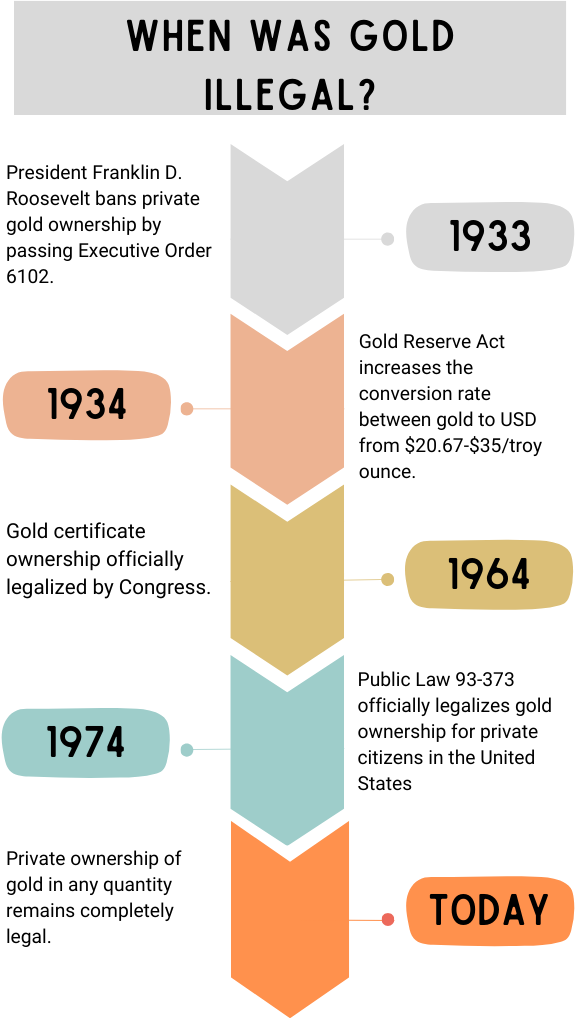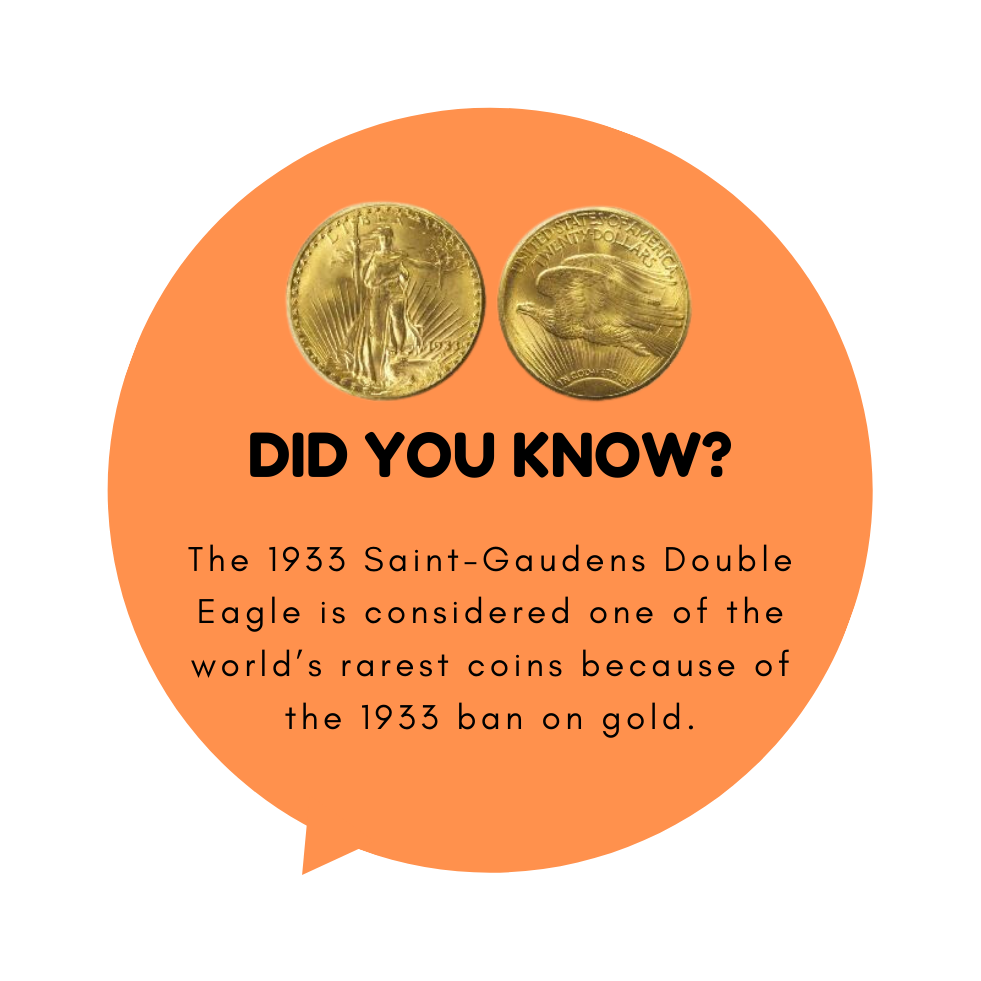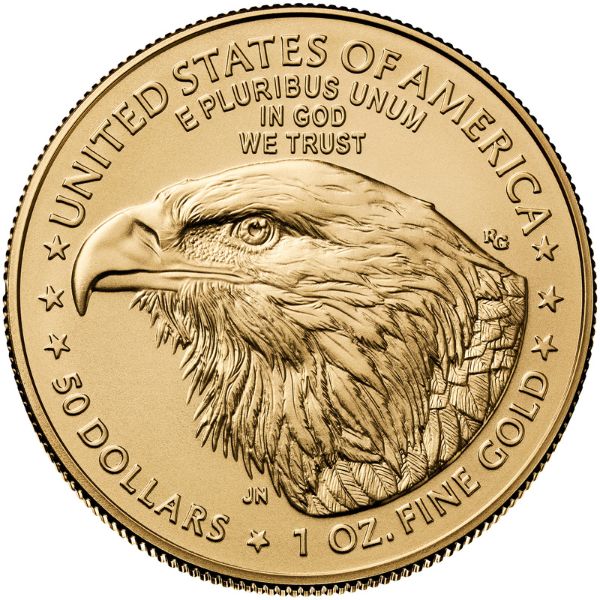Is It Illegal to Own Gold in 2024?

At a Glance:
- It is not illegal to own gold – private citizens can purchase and store as much gold bullion as they’d like.
- Gold was illegal to hoard from 1933 until 1974 under Executive Order 6102.
- “Gold confiscation” is a high-pressure sales tactic that some dealers use to convince people to buy gold.
Is it Illegal to Own Gold in 2024?
“Gold confiscation” is one of bullion’s most enduring myths. Here’s the good news: it’s completely legal to own gold. Stackers can load up on as many gold coins and bars as their wallets can afford. Depending on how stackers choose to invest, some gold bullion products may come with additional tax requirements. In 2024, taxation is as close as we can get to any kind of gold prohibition/confiscation.
It’s unlikely that gold will ever be banned again, although there was a period in American history where hoarding gold was against the law. From 1933 to around 1974, FDR’s Executive Order 6102 prohibited private U.S. citizens from hoarding certain types of gold bullion. The law was repealed (sort of) in 1774. Since then, owning gold privately has been completely legal.
What’s the story behind the gold prohibition of the mid-1900s? Investors don’t need to worry about the government confiscating their gold in 2024, but it’s still important to understand why FDR banned gold stacking. For the modern gold stacker, reading up on this period of American history is vital to avoiding the gold confiscation rumors used by some dealers to persuade consumers to buy more bullion.
Timeline of Events – When Was Gold Illegal?
Gold was illegal for private investors to hold from 1933 to 1974. The controversial Executive Order 6102 began the decades-long ban on hoarding gold that prevented private investors from purchasing or stacking gold coins and bars. It wasn’t until 1964 that gold certificates would once again be a legal way to invest. Ten years later, President Gerald Ford put the final nail in the coffin of Executive Order 6102 when he made it legal for private citizens to hold any amount of gold.
This forty-year controversy is only the tip of the iceberg. While gold is legal to own today, investors were prohibited from stacking any type of gold bullion for just over four decades. Let’s take a closer look at the history of gold prohibition – the period of American history where gold was illegal.

1933 – FDR Bans Gold Ownership
On April 5, 1933, President Franklin D. Roosevelt shocked the country when he signed Executive Orde 6102. The law forced all private citizens to sell their gold holdings back to the government for a set conversion rate ($20.67/oz). Certain gold collections were except from this requirement. Namely, investors were allowed to hold onto:
- Gold used for a profession (e.g. gold belonging to a luxury watchmaker)
- Gold collections worth less than $100 total
- Gold being held for a foreign government; and
- Gold currently being used for legal transactions
Clearly, these exceptions didn’t do much for avid gold stackers at the time. FDR’s ban on gold was met with swift opposition from investors. This shouldn’t be surprising. Think about what public reaction would look like if the American government banned gold today! Stacking gold bars had long been an American tradition prior to 1933, and FDR’s ban on gold hoarding was as big of a deal then as it would be to investors in 2024.
Executive Order 6102 also had another unlikely consequence – it created one of the most famous, rare, and expensive coins in modern history.
Unintended Consequence: The Mythically Rare 1933 Gold Double Eagle
Prior to FDR’s gold ban in 1933, over 440,000 Saint-Augustus Double Eagles were manufactured at the U.S. Mint. When news came down of the impending ban on private gold ownership, the mint was ordered to melt all of these coins down. It’s worth noting that, at the time, the American Double Eagle was considered one of the crowning achievements of the country’s minting system.

The U.S. Treasury anticipated that the coin’s sales numbers would be high, as they had been in previous years. The problem? With private gold ownership illegal, there would be nobody to sell the beautiful 1933 gold coin to. They complied with their orders, melting down almost all of the Saint-Gaudens Double Eagles they had minted in 1933.
To preserve some semblance of the coin’s history, the U.S. Mint was allowed to save two of the 1933 Double Eagles. Some mint employees sensed that these coins might be valuable some day. Historians believe that around twenty additional 1933 Saint-Gaudens Double Eagle Coins were illegally pocketed by workers at the national mint.
Today, the 1933 Saint-Gaudens Gold Double Eagle Coin is widely considered to be the most valuable gold coin in the world. Value estimates for the 1933 Double Eagle range from $10-15 million dollars. Because of the 1933 gold ban by President FDR, only 22 specimens are known to survive in 2024.
The Saint-Gaudens Double Eagle is already one of the most recognizable gold coins on the planet. To many collectors, the 1933 edition of the coin is the ultimate holy grail. And why wouldn’t it be? We can’t think of any other coin with a history quite as fascinating as the mythically rare 1933 Saint-Gaudens Double Eagle Gold Coin.
1934 – Congress Raises the Price of Gold
Congress’ next move after banning gold hoarding was to increase the value of the precious metal. Under the guidance of FDR, America’s legislators passed the Gold Reserve Act in 1934. This law increased the exchange rate of gold from $20.67 to $35 per troy ounce. To gold investors who were just forced to sell their stacks at the lower conversion rate, this move was incredibly controversial.
In reality, historians believe that the Gold Reserve Act’s intention had little to do with gold prices. Instead, the Gold Reserve Act was actually meant to give the government more control over the value of the United States Dollar (USD). The legislation didn’t just increase the conversion rate of gold; it gave the United States government the ability to do so. By changing the conversion rate of gold, the government was able to exert more control over the value of USD.

The Gold Reserve Act was extremely controversial and complex. Our takeaway: the legislation’s main purpose was to allow the government more control over the value of their currency.
While there was an series of intense legal battles over this law in the decades that followed, gold stackers didn’t see much progress toward being reunited with their favorite investment until 1964.
1964 – Gold Certificate Ownership is Legalized
Gold investors got a bit of relief in 1964. Congress made it legal for citizens to own gold certificates. A gold certificate is a lot like a stock in gold. When someone owned a gold certificate, they functionally owned a stock in gold. Certificates could be bought and sold in 1964, which allowed investors to speculate on the value of gold relative to the United States Dollar.
The new law came with an important caveat, though. While investors were allowed to buy and sell gold certificates, they were not able to exchange these certificates for the physical gold they represented. In other words, holding gold remained illegal in 1964, even though citizens were allowed to purchase ‘paper gold’ using gold certificates.

Gold certificates are actually still around today, although they don’t represent physical gold like they used to. In 2024, gold certificates are traded for their collectible value.
1974 – Congress Fully Legalizes Gold Ownership
Ten years after gold certificates became legal investments, Congress finally repealed the last vestiges of the 1933 ban on gold bullion.
Public Law 93-373 states that its purpose was to:
Permit United States citizens to purchase, hold, sell, or otherwise deal with gold in the United States and abroad.
With the passage of this law, Americans were once again allowed to buy, sell, and even hoard as much gold bullion as they wanted to. The market reaction was immediate. Historical gold price charts show that the precious metal’s price rose by around 75% from 1973 to 1974. Needless to say, investors were excited to be able to continue building their gold stacks.
It took around 41 years, but the 1933 ban on gold ownership was eventually repealed under the leadership of President Gerald Ford.
Is Gold Confiscation a Myth?
Gold confiscation is a myth used to pressure consumers into buying more gold. Like all good myths, the legend of gold confiscation is loosely based on reality. Gold really was banned for about 40 years in the mid-1900s. After 1974, the government made it legal for people to buy, sell, and hoard gold bullion coins and bars.
The reason gold confiscation isn’t likely to happen again is that it wouldn’t be necessary. The original gold ban enacted by FDR during 1933 was a desperate measure to regain control of the United States Dollar during the Great Depression. Moreover, a gold confiscation wouldn’t be effective today because the U.S. is no longer on the gold standard. The government wouldn’t gain very much from confiscating gold bars from citizens in 2024 – especially if they wanted to increase government control over currency like FDR wanted.
Is it Illegal to Own Gold Today?
Today, it is completely legal to own gold. Investors are free to buy and sell as much gold as they want. Gold bars, coins, and jewelry is legal to buy, and there are no restrictions on how much gold one person can possess in 2024. “Gold confiscation” is a common myth perpetuated by gold dealers and collectors. Generally, the people who promote this myth are trying to get others to buy as much gold as possible. Nobody is going to take your gold away from you.
While gold isn’t illegal in 2024 and likely never will be, investors should understand the tax implications of buying/selling gold. Gold isn’t illegal, but unreported capital gains certainly are!
You might also be interested in:
About The Author
Michael Roets
Michael Roets is a writer and journalist for Hero Bullion. His work explores precious metals news, guides, and commentary.
